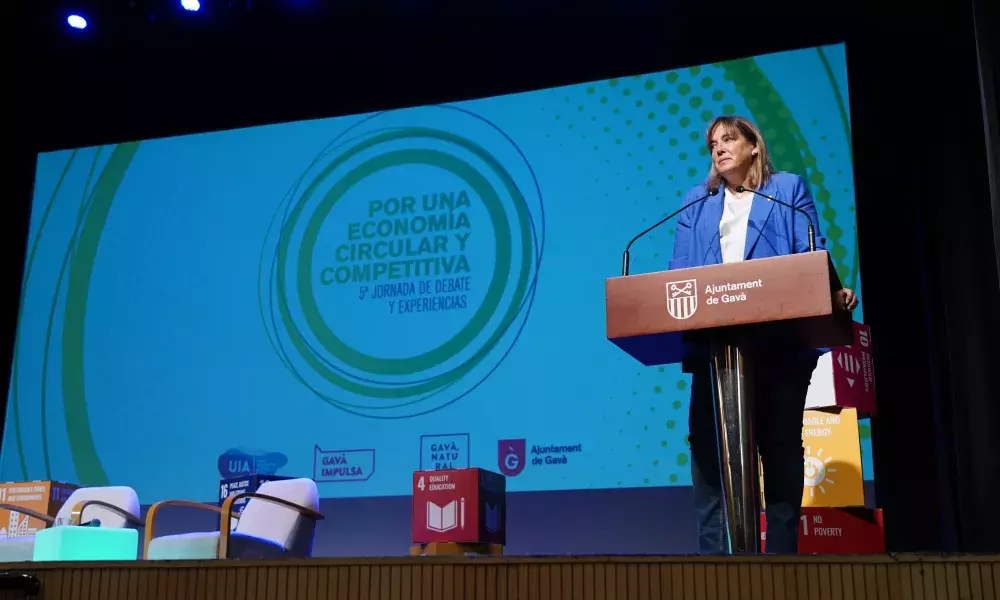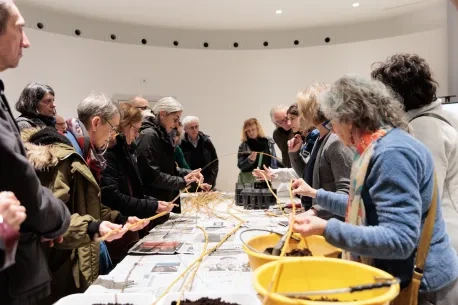GAVIUS joins the 5th Edition of the Conference “For a Circular and Competitive Economy”

For the Gavà City Council "among the elements that must articulate the new environmental policies, the generation of green [and] circular economies occupies a pre-eminent space". For this reason, it has been involved in defining a sustainable and competitive development strategy where the circular economy is articulated based on solid values and firm commitments, defining a scenario where economic sustainability is coherently linked to urban and territorial sustainability. As part of this process, the Gavà City Council has been holding the conference 'For a Circular and Competitive Economy' for 5 years, which is conceived as a space for the exchange of experiences between networks, stakeholders and institutions. Furthermore, the Gavà City Council frames its green transition efforts within a broader approach aiming at generating sustainable changes conducive of a deep transformation of local economy and society, which is not only green, but also digital and fair. Thus, in accordance with the objectives of the European Green Deal and the Digital Agenda, it intends to foster an economy that works for everyone; enhancing skills and equipping people for new green and digital jobs; promoting social progress and just transitions as well as ensuring no one is left behind and providing access to essential services for all, which is indeed at the core of GAVIUS mission.
Departing from these premises, this year, the event offered the opportunity to take stock of the lessons learnt from several European projects carried out in recent years. Specifically, URBACT and UIA projects, including GAVIUS, have been the central protagonists of the second international day of the programme, which has featured several complementary experiences altogether aiming to build modern, greener and fairer cities.
After the welcoming speech from the Deputy Mayor and Spokeperson of the Gavà City Council, Jordi Tort, we have had the opportunity to listen directly from Tim Caulfield, Director of the UIA initiative, and Adele Bucella, Projects and Programming Head of Unit in the URBACT secretariat.
In his presentation, Tim Caulfield highlighted the breadth, variety and magnitude of the projects funded so far by UIA, the innovativeness and ambition of the solutions proposed by each of them to different urban challenges and their alignment with the European Urban Agenda and its priorities. After illustrating the different actions put in place by UIA to support its knowledge management strategy and capitalise as much as possible the most promising project’s results, he described how the future European Urban Initiative (EUI) will look like, which main objectives are stated in the newly approved European Regional Development Fund (ERDF) regulation. Within this framework, the European Commission will launch in the Q3/2022 a new European Urban Initiative (EUI) financed by the ERDF to support cities with innovative actions, capacity and knowledge building, policy development and communication on sustainable urban development. The new coordination framework the EUI will entail is thought to provide cities with a more holistic and integrated tool “federating” all the different strands of urban initiatives under a broader umbrella with a view to exploit more and better interactions and spillovers. In this context, the first call of the new European Urban Innovative Actions is expected to be launched next autumn. For more information Tim’s presentation is available here.
In line with the new legislative framework presented by the UIA Director, Adele Bucella explained the audience what the role and strategic importance of the upcoming URBACT IV programme in this renovated context will be. In fact, despite not being formally part of the new EUI, URBACT IV will maintain its specific role to act as territorial cooperation programme providing cities with knowledge, capacities and participation opportunities. All in all, the new programme will build upon the URBACT III legacy and the lessons learnt from the previous programming period to continue in its mission to promote integrated local sustainable development through city-to-city cooperation. Importantly, Adele stressed one of the main novelties which will be represented by the Innovation Transfer Mechanism, i.e. a new funding instrument to allow city networks to elaborate investment plans for replicating elements and solutions of Urban Innovative Actions. For more information Adele’s presentation is available here.
After the speeches from the two UIA and URBACT representatives, it was time to engage in an interactive round table moderated by Jon Aguirre, URBACT National Contact Point, and listen from the direct experience of several URBACT networks and the Spanish cities partaking to them. Specifically, Antonio Zafra, URBACT Lead Expert, has made an overview on the URBACT networks and their evolution, focusing on the most recent ones linked to the circular economy and sustainable food, such as Diet For A Green Planet, AGRI-URBAN and Food Corridors.
Furthermore, the round table featured BIOCANTEENS, the URBACT network partnered by Gavà, aiming to ensure the distribution of sustainable school meals in the participating cities. Its objectives, scope and current status were presented by our own Isabel Arnet, Director of the Office of Sustainable Development, Innovation and International Economic Strategy, Work and Promotion of the City of Gavà, who is also the leading Project Manager for GAVIUS. Although different from GAVIUS in scope and purpose, the URBACT project BIOCANTEENS represents a precious opportunity for the city of Gavà to establish synergies and participate in enriching city-to-city learning exchange processes, which will be extremely valuable for GAVIUS post-project implementation at municipal scale. Furthermore, the list of social aids that GAVIUS aims to help manage more efficiently, and whereas possible automate, comprises also municipal subsidies for school canteens. Thus, the work done in BIOCANTEENS via the construction of a local stakeholder group including schools, parents’ associations and other stakeholders of the local education community will be a key resource to take advantage of in the next phase of GAVIUS deployment. Last, Jorge Villar, Councillor for Tourism, Innovation, Technological Development and Transparency in the City Council of Cáceres, presented the RESOURCEFUL CITIES project, an URBACT Action Planning Network of ten European cities. This project seeks to develop the next generation of urban resource centres conceived as space for co-creation and action, so they can serve as catalysts of the local circular economy, by adopting a participative and integrated approach. The resource centres strive to promote the positive economic, environmental and social impacts, notably for the circular economy, by facilitating waste prevention, reuse, repair and recycling.
Last and most importantly, it was the turn of GAVIUS and two more UIA projects led by Spanish municipal authorities to share their experiences and discuss common challenges. In particular, first, we heard from Robert Raga, Mayor of Riba-Roja de Túria, about the conceptualisation phase and the current implementation of GUARDIAN, ongoing UIA project funded under the “Climate Adaptation” priority which core innovation is rooted upon a combined strategy based on the use of recycled water for fire mitigation and protection. The urban areas of Riba-Roja and Paterna, share the protected wildland zone “La Vallesa”, which is part of the Natural Park “Parque Natural del Turia”, and is subject to the growing risk posed by forest fires, further impacted by the effects of climate change. In this sense, the project required a strict collaboration and firm commitment from the two city administrations as well as the construction of a complex public-private partnership, both elements clearly present in other UIA projects, such as GAVIUS, led by small cities that have decided to establish alliances with neighbouring and/or like-minded cities to apply together for UIA funding and develop jointly territorial strategies.
Robert’s presentation is available here.
Second, Fernando González, Architect at EPIU Getafe, illustrated the EPIU project born as a continuation of the work developed by the Municipal Land and Housing Company of Getafe, S.A. (EMSV) in favour of building rehabilitation and urban regeneration and renewal. Indeed, EPIU was born from the administration’s awareness that bolder and more innovative actions were needed to detect and act against "hidden" energy poverty, departing from the design of the needed tools and infrastructure to collect and analyse data, identification and clustering of the households’ needs to the provision of energy advice as well as the comprehensive refurbishment of the building, whereas required.
Fernando’s presentation is available here.
EPIU and GAVIUS, finally presented by Toni Merino, Manager of the Mataró City Council, expert in public management and innovation, responsible for the digital transformation process of Mataró, together with Cristina Martinez, Director of Governance and Internal Management, Area of New Governance and General Services of the Gavà City Council, share several complementarities and commonalities. First and foremost, both projects devote considerable investments in ground-breaking technological innovation with specific emphasis on data analytics and AI based solutions. Thus, the two projects have been facing specific ethics, data privacy and security issues that have been handled in collaboration with their respective academic and RTD partners. Furthermore, the two projects target partly similar population groups as they both dedicate specific attention to those vulnerable groups that are at a disproportionate risk of poverty, thus likely to become eligible for social aids as well as more susceptible to energy poverty.
For this reason, further synergies and interactions among the two projects would be indeed advisable and welcomed as both EPIU and GAVIUS aim to support a paradigmatic shift from reactive to proactive and predictive administrations capable to early detect situations of vulnerability and promptly identify the most appropriate solution, aid and service.
The closure session granted the audience the opportunity to join an interesting debate around the present and future role of European funds and projects in the promotion of the integrated, sustainable and inclusive development of local and metropolitan areas. The speakers’ presentations can be downloaded here.
The event was web-streamed and the full recording of the two days is available on GAVIUS website (English), on the event’s page (Spanish) and on YouTube. A report summarising conclusions and remarks from these inspiring two days will be shortly available at the same links above.
About this resource
The Urban Innovative Actions (UIA) is a European Union initiative that provided funding to urban areas across Europe to test new and unproven solutions to urban challenges. The initiative had a total ERDF budget of €372 million for 2014-2020.
Similar content




